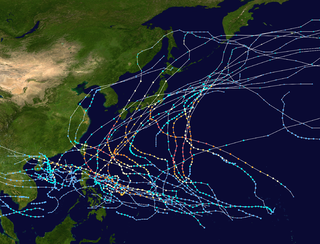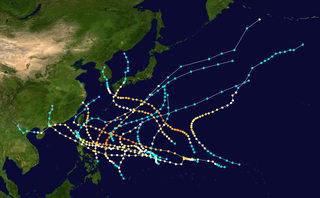Related Research Articles

The 2003 Pacific typhoon season was a slightly below average yearlong period of tropical cyclogenesis exhibiting the development of 45 tropical depressions, of which 21 became named storms; of those, 14 became typhoons. Though every month with the exception of February and March featured tropical activity, most storms developed from May through October. During the season, tropical cyclones affected the Philippines, Japan, China, the Korean Peninsula, Indochina, and various islands in the western Pacific.

The 1993 Pacific typhoon season was the most active season for the Philippines, seeing a total of 32 storms forming or entering their area of responsibility. Overall, it was an average season, spawning 28 tropical storms, 15 typhoons and three super typhoons. The season had no official bounds; it ran year-round in 1993, but most tropical cyclones tend to form in the northwestern Pacific Ocean between May and November. These dates conventionally delimit the period of each year when most tropical cyclones form in the northwestern Pacific Ocean.

The 1983 Pacific typhoon season was the latest start for a Pacific typhoon season on record, and also slightly below-average in terms of named storms. It ran year-round in 1983, but all tropical cyclones formed between June and December. These dates conventionally delimit the period of each year when most tropical cyclones form in the northwestern Pacific Ocean. A total of 32 tropical depressions formed this year, of which only 23 became tropical storms and were assigned a name by the Joint Typhoon Warning Center. Additionally, tropical depressions that enter or form in the Philippine area of responsibility are assigned a name by the Philippine Atmospheric, Geophysical and Astronomical Services Administration or PAGASA. This can often result in the same storm having two names. This year, a total of 23 storms were named this way.

The 1978 Pacific typhoon season was a very active season that produced 31 tropical storms, 16 typhoons and one intense typhoon. It ran year-round in 1978, but most tropical cyclones tend to form in the northwestern Pacific Ocean between June and December. These dates conventionally delimit the period of each year when most tropical cyclones form in the northwestern Pacific Ocean.

The 1965 Pacific typhoon season has no official bounds; it ran year-round in 1965, but most tropical cyclones tend to form in the northwestern Pacific Ocean between June and December. These dates conventionally delimit the period of each year when most tropical cyclones form in the northwestern Pacific Ocean.

The 1960 Pacific typhoon season had no official bounds; it ran year-round in 1960, but most tropical cyclones tend to form in the northwestern Pacific Ocean between June and December. These dates conventionally delimit the period of each year when most tropical cyclones form in the northwestern Pacific Ocean.

The 1954 Pacific typhoon season has no official bounds; it ran year-round in 1954, but most tropical cyclones tend to form in the northwestern Pacific Ocean between June and December. These dates conventionally delimit the period of each year when most tropical cyclones form in the northwestern Pacific Ocean.

The 1946 Pacific typhoon season has no official bounds; it ran year-round in 1946, but most tropical cyclones tend to form in the northwestern Pacific Ocean between June and December. These dates conventionally delimit the period of each year when most tropical cyclones form in the northwestern Pacific Ocean.
The 1939 Pacific typhoon season has no official bounds; it ran year-round in 1939, but most tropical cyclones tend to form in the northwestern Pacific Ocean between May and November. These dates conventionally delimit the period of each year when most tropical cyclones form in the northwestern Pacific Ocean.

Typhoon Gordon, known in the Philippines as Typhoon Goring, was a powerful tropical cyclone that caused widespread damage and loss of life in the Philippines and Southern China in July 1989. Gordon developed into a tropical depression near the Northern Mariana Islands on July 9 and quickly intensified as it tracked west-southwestward. On July 13, the storm attained typhoon status and subsequently underwent a period of rapid intensification. By July 15, the storm attained its peak strength as a Category 5 equivalent super typhoon with winds estimated at 260 km/h (160 mph). After striking the northern Philippines, Gordon moved through the South China Sea and slowly weakened. On July 18, the storm made landfall in southern China and was last noted the following day as it dissipated over land.

In 1900, 23 tropical cyclones were observed in the western Pacific Ocean, north of the equator and west of the International Date Line. In that region of the world, cyclones that attain maximum sustained winds of at least 118 km/h (73 mph) are known as typhoons. Of the 23 storms, 13 were tracked by the Hong Kong Observatory. Activity occurred from January to December, although the majority of the storms formed from June to November.
There were 30 tropical cyclones in the western Pacific Ocean in 1931, including 19 typhoons, as well as one that developed in December of the previous year. The most significant typhoon was one that struck eastern China near Shanghai in the midst of the country's worst floods on record; heavy rainfall caused levees to collapse along the Grand Canal, killing an estimated 300,000 people, including about 2,000 people overnight in the city of Gaoyou.

The following is a list of Pacific typhoon seasons from 1902 to 1919. Data from these years was extremely unreliable, so there were many more typhoons that did not hit land and were not detected by ships.
The following is a list of Pacific typhoon seasons from 1920 to 1937. Data from these years was extremely unreliable, so there were many more typhoons that did not hit land and were not detected by ships. The average from these times was 23 tropical storms, which now would be considered a well-below-average season.
This article encompasses the 1870s Pacific typhoon seasons. While data is not available for every storm that occurred, some parts of the coastline were populated enough to give data of typhoon occurrences.
This article encompasses the 1890s Pacific typhoon seasons.
References
- ↑ Huang, G; Yim, Wyxx W-S. "Reconstruction of an 8,000-year record of Typhoons in the Pearl River Estuary, China" (PDF). HKU Scholars Hub.
- ↑ "23 Oct 1862 - TERRIFIC TYPHOON IN THE CHINA WATERS, AND IMMENSE LOSS OF LIFE. - Trove". Courier. Trove.nla.gov.au. 23 October 1862. Retrieved 2022-03-26.
- 1 2 3 4 5 6 7 R. García-Herrera; P. Ribera; E. Hernández; L. Gimeno (2010). The Selga Chronology Part I: 1348-1900. Typhoons in the Philippine Islands 1566-1900 (Report). JGR - Atmospheres. Retrieved 2014-07-27.